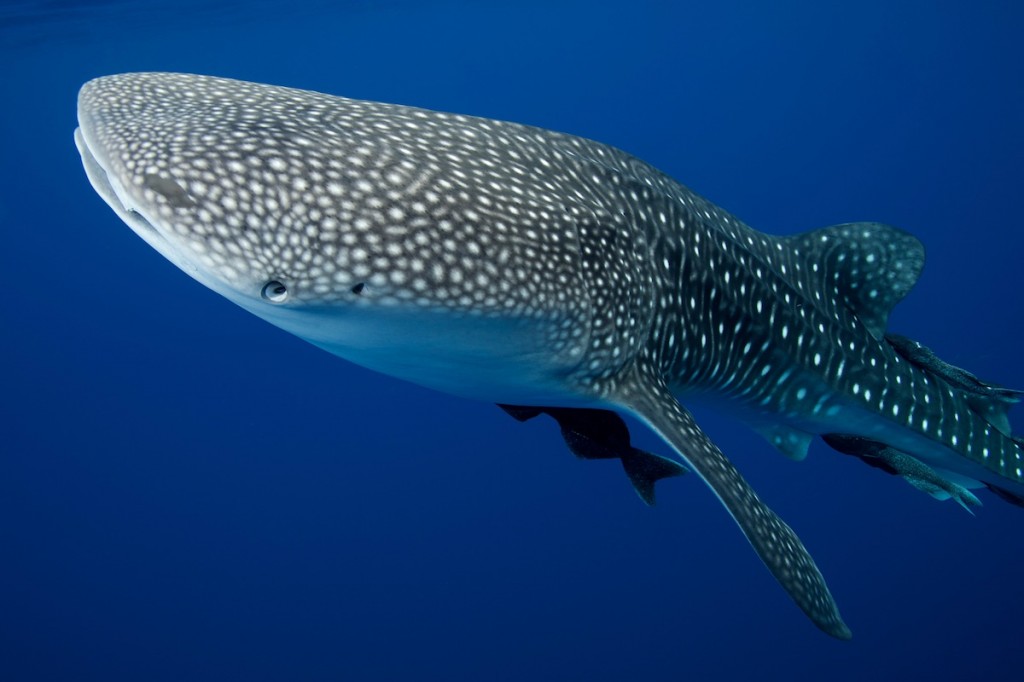- Home
- Accommodation
- Activities
- Area Info
- Maps
- Photo Galleries
- Real Estate
- Travel
Whale Sharks – Occasional Visitors to Montezuma’s Waters
Whale sharks occasionally are found in the beautiful waters of Montezuma and other surrounding areas. Their length has actually been compared to a huge bus (40-60 feet!) And the weight of these whale sharks can be measured up to 20.6 tons. The whale shark is scientifically labeled ‘Rhincodon typus’. Due to it’s immense weight and girth, the whale shark moves slower than all other sharks in the water. They are know as ‘the largest fish in the sea’ and whale sharks have broken several long-standing records in sheer size and weight. Scientists have mentioned that they may actually rival the size of pre-historic dinosaur sharks! It is mind boggling, the extent of their size and how they move in the water. The origin of the whale shark can be traced back 50 – 60 million years. They are a very long-lived fish… up to 70 years. They prefer warm waters to reside in, which is why they can be found in places like Tambor Bay, Cabuya, and the Tortuga Islands. Tourists from all over the world come to observe this majestic specimen in its natural element in Costa Rica.
More about the Whale Sharks
Whale sharks are usually called ‘filter feeders’. The reason for this is that they travel with their humongous mouths open and collect plankton in their mouths along with tiny animals and fish. After collecting the food, they release the water from filters set in their jaws until only the plankton is left. This way, they manage to feed themselves for the entire day and leave other bigger fish alone. Whale sharks are often found in areas near Mexico, namely Isla Holbox and Isla Mujeres. These sharks don’t wander too deeply into the depths of the sea, preferring instead to stay near the surface and closer to land. When they are seen near Montezuma, it’s usually cruising along the coastline, perhaps 100m from shore. These fish are also in the habit of migration; when winters roll around they migrate to warmer areas and live there until the climate in their previous location is better suited to them. In Mexico (Yucatan coast) an entire school of whale sharks was recorded in 2011.
Divers and Whale Sharks
In Montezuma, divers have sometimes been able to interact with whale sharks. They seem huge and monstrous but are actually a very gentle creature of the sea. Scientists have reported that young whale sharks often engage in playful behavior with humans. The danger with whale sharks is not that they will purposely hurt the divers. The main threat occurs because these massive fish move with humongous mouths open. An incident was covered by the press where a human diver almost died due to being sucked into the mouth of a huge whale shark. This happened near Mexico on Isla Mujeres. Since then, people have been more careful to steer clear of the direct path in front of the whale shark when it is moving in the water. The force of it’s sucking can be surprisingly strong. Divers often will also hang onto the top fin to hitch a ride on a whale shark. However, many professional dive companies have a policy of never touching anything while under the water, whether it’s whale sharks, starfish, coral, or anything else, which of course is safest both for divers and the animals. “Look but don’t touch” is an excellent policy.
Costa Rica “Baby” Whale Shark Video
References
Jurassic Shark (2000) documentary by Jacinth O’Donnell; broadcast on Discovery Channel, 5 August 2006
Norman, B. (2005). “Rhincodon typus“. IUCN Red List of Threatened Species. International Union for Conservation of Nature. Retrieved 18 August 2011.
Martin, R. Aidan. “Rhincodon or Rhiniodon? A Whale Shark by any Other Name”
Great Stuff

Clandestina Restaurant
My new favorite restaurant, Clandestina is not to be missed by food lovers staying anywhere near to Montezuma. Established in March 2015, Clandestina is the new kid on the block. The Oregon/Tico collaboration is a winner among locals and travelers alike, with artisan craft beers, made onsite by Butterfly Brewing Co. and delicious, exciting […]












